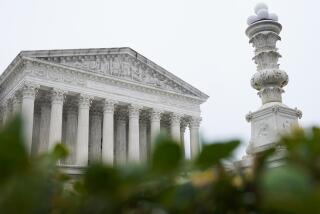Partisan gerrymandering is almost as old as America, but will the Supreme Court decide it has gone too far?

Democrats maintain that the GOP has given itself an unfair grip on power in the House of Representatives. (June 19, 2017) (Sign up for our free video newsletter here http://bit.ly/2n6VKPR)
Reporting from Washington — The Supreme Court agreed Monday to decide whether partisan gerrymandering — in which voting districts are drawn to favor one party — is a time-honored American political tradition or has evolved into an unconstitutional rigging of elections.
The Wisconsin case of Gill vs. Whitford, to be heard in the fall, could yield one of the most important rulings on political power in decades.
Gerrymandering has been derided for generations, often mocked in cartoons depicting bizarre-shaped districts that look like salamanders or spiders.
But in recent decades, because of software programs, gerrymandered maps look less obvious and are more effective in giving one party an insurmountable advantage. The maps can all but ensure that the party in power at the beginning of a decade — when districts are drawn — will keep control of a state legislature and win most of a state’s seats in the U.S. House of Representatives.
Democrats maintain that the Republican Party has used its control of electoral maps after the 2010 census to give Republicans an unfair grip on power in Congress.
For example, Pennsylvania, Ohio and Michigan are closely divided states in terms of party affiliation and all voted for former President Obama. Yet 34 of their 48 House representatives are Republican largely because of gerrymandering.
North Carolina’s electoral map was rejected by the Supreme Court recently for illegally using race in an effort to create more GOP-leaning districts. It sends 10 Republicans and three Democrats to the House, even though statewide races often reflect a population that is narrowly divided.
Democrats have played the same game, although they now control far fewer states. In Maryland, Democrats drew a map that allowed their party to control seven of the eight seats in the House.
What is unclear is whether the justices see this as politics as usual. The Supreme Court has viewed political gerrymandering as distasteful but not illegal. The justices have never struck down a state’s electoral map because it was unfairly partisan, though they have outlawed gerrymandering along racial lines.
Voting rights advocates are hopeful that it will be different this time. They say party leaders have gone too far in rigging the system in their favor.
Paul Smith, a lawyer for the Campaign Legal Center, said gerrymandering “is worse now than any time in recent memory.” He represents a dozen Democratic voters from Wisconsin who sued the state over its electoral map for the state Assembly.
The map makes it likely the GOP will win a supermajority of seats in the Assembly even when more votes are cast statewide for Democrats than for Republicans.
In 2012, 51% of Wisconsin voters cast ballots for Democrats in the state legislative races, compared with 48.6% for Republicans. But Republicans still won 60 of the 99 seats in the Assembly.
Last year, a three-judge federal panel agreed with the challengers and ruled 2 to 1 that the Wisconsin map was unconstitutional. The map’s “motivating factor” was an “intent to entrench a political party in power,” said Judge Kenneth Ripple, a Reagan appointee to the U.S. 7th Circuit Court of Appeals in Chicago. The judges cited the work of University of Chicago law professor Nicholas Stephanopoulos, who devised a mathematical formula that showed the Wisconsin plan was an extreme gerrymander.
Trevor Potter, president of the Campaign Legal Center and former Republican chairman of the Federal Election Commission, urged the high court to affirm that decision. “The threat of partisan gerrymandering isn’t a Democratic or Republican issue. It’s an issue for all American voters,” he said. “We’re confident that when the justices see how pervasive and damaging this practice has become, the Supreme Court will adopt a clear legal standard that will ensure our democracy functions as it should.”
The Republican National Committee does not share his assessment of the problem or the solution. Its lawyers urged the Supreme Court to take up the Wisconsin case and uphold the state’s map. They argued that their party’s advantage reflects the “reality of political geography.” They say Democratic voters are concentrated in the cities, giving the GOP a big edge elsewhere. “The Constitution contains no right to proportional representation in legislative bodies based on statewide totals,” they argued.
Wisconsin’s attorney general directly appealed to the Supreme Court. The state’s lawyers said the districts were compact and neatly drawn. They said the Democrats are at a disadvantage because their voters are concentrated in Milwaukee and Madison.
They urged the court to overturn the lower-court ruling and throw out the claim on the grounds that redistricting is a political process, not a legal one. They also won a procedural ruling on Monday that could be a good omen for the Republicans.
Shortly after announcing the court would hear the case, the justices issued an order that put on hold the lower court’s decision that required Wisconsin lawmakers immediately redraw the map for its legislative districts. The order came on a 5-4 vote. The four Democratic appointees — Justices Ruth Bader Ginsburg, Stephen G. Breyer, Sonia Sotomayor and Elena Kagan — dissented.
That means the court’s five Republican appointees voted with Wisconsin’s Republican leaders. The five justices apparently agreed with the state’s argument that it should not be forced to redraw the map until the high court finally rules on its constitutionality. But the order also suggests they are skeptical of the lower court’s ruling.
Twitter: DavidGSavage
ALSO
Decision time at the Supreme Court: Rulings expected soon on religion, free speech and immigration
Trump visits Supreme Court justices as the fate of his travel ban hangs in the balance
In his first Supreme Court opinion, Gorsuch shows writing flair, strict interpretation of law
UPDATES:
1:30 p.m.: This article was updated throughout with more background and analysis.
8 a.m.: This article was updated with the high court’s order putting a hold on a lower-court order requiring Wisconsin to redraw the map for its legislative districts.
This article was originally published at 6:45 a.m.
More to Read
Get the L.A. Times Politics newsletter
Deeply reported insights into legislation, politics and policy from Sacramento, Washington and beyond. In your inbox three times per week.
You may occasionally receive promotional content from the Los Angeles Times.











